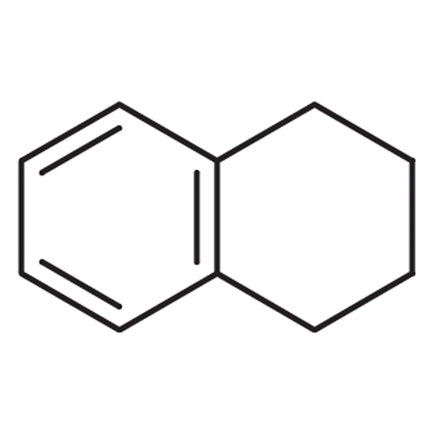Maximum quantity allowed is 999
Please select the quantity
CAS RN: 119-64-2 | Product Number: T0107
1,2,3,4-Tetrahydronaphthalene

Purity: >97.0%(GC)
Synonyms:
Product Documents:
| Size | Unit Price | Same Day | 2-3 Business Days |
|---|---|---|---|
| 25ML |
$18.00
|
Contact Us | ≥80 |
| 500ML |
$24.00
|
≥40 | ≥100 |
* Please contact our distributors or
TCI
to order our products. The above prices do not include freight cost, customs, and other charges to the destination.
* The storage conditions are subject to change without notice.
| Product Number | T0107 |
| Purity / Analysis Method | >97.0%(GC) |
| Molecular Formula / Molecular Weight | C__1__0H__1__2 = 132.21 |
| Physical State (20 deg.C) | Liquid |
| Storage Temperature | Room Temperature (Recommended in a cool and dark place, <15°C) |
| Store Under Inert Gas | Store under inert gas |
| Condition to Avoid | Air Sensitive |
| CAS RN | 119-64-2 |
| Reaxys Registry Number | 1446407 |
| PubChem Substance ID | 87576117 |
| SDBS (AIST Spectral DB) | 907 |
| Merck Index (14) | 9221 |
| MDL Number | MFCD00001733 |
Specifications
| Appearance | Colorless to Almost colorless clear liquid |
| Purity(GC) | min. 97.0 % |
Properties (reference)
| Melting Point | -36 °C |
| Boiling Point | 207 °C |
| Flash point | 75 °C |
| Specific Gravity (20/20) | 0.97 |
| Refractive Index | 1.54 |
| Solubility in water | Insoluble |
| Degree of solubility in water | 47 mg/l 28 °C |
| Solubility (miscible with) | Benzene, Alcohol, Ether |
GHS
| Pictogram |



|
| Signal Word | Danger |
| Hazard Statements | H302 : Harmful if swallowed. H315 : Causes skin irritation. H319 : Causes serious eye irritation. H373 : May cause damage to organs through prolonged or repeated exposure. H336 : May cause drowsiness or dizziness. H304 : May be fatal if swallowed and enters airways. H411 : Toxic to aquatic life with long lasting effects. H227 : Combustible liquid. |
| Precautionary Statements | P501 : Dispose of contents/ container to an approved waste disposal plant. P273 : Avoid release to the environment. P260 : Do not breathe dust/ fume/ gas/ mist/ vapors/ spray. P270 : Do not eat, drink or smoke when using this product. P210 : Keep away from heat/sparks/open flames/hot surfaces. No smoking. P271 : Use only outdoors or in a well-ventilated area. P264 : Wash skin thoroughly after handling. P280 : Wear protective gloves/ eye protection/ face protection. P302 + P352 : IF ON SKIN: Wash with plenty of water. P370 + P378 : In case of fire: Use dry sand, dry chemical or alcohol-resistant foam to extinguish. P391 : Collect spillage. P331 : Do NOT induce vomiting. P314 : Get medical advice/ attention if you feel unwell. P337 + P313 : If eye irritation persists: Get medical advice/ attention. P305 + P351 + P338 : IF IN EYES: Rinse cautiously with water for several minutes. Remove contact lenses, if present and easy to do. Continue rinsing. P362 + P364 : Take off contaminated clothing and wash it before reuse. P332 + P313 : If skin irritation occurs: Get medical advice/ attention. P301 + P310 : IF SWALLOWED: Immediately call a POISON CENTER/doctor. P304 + P340 + P312 : IF INHALED: Remove person to fresh air and keep comfortable for breathing. Call a POISON CENTER/doctor if you feel unwell. P403 + P233 : Store in a well-ventilated place. Keep container tightly closed. P403 + P235 : Store in a well-ventilated place. Keep cool. P405 : Store locked up. |
Related Laws:
| RTECS# | QK3850000 |
Transport Information:
| UN Number | UN3082 |
| Class | 9 |
| Packing Group | III |
| H.S.code* | 2902.90-000 |
Application
Preparation of Anhydrous Hydrogen Bromide

Typical procedure: Bromine is slowly added dropwise to a round bottom flask containing a suspension of iron and 1,2,3,4-tetrahydronaphthalene. In the early stage of the reaction, the flask is cooled with water. The reaction is warmed to 30 to 40 ℃ allowing gas evolution. The gas is passed through a wash bottle containing 1,2,3,4-tetrahydronaphthalene in order to eliminate any bromine in the hydrogen bromide. For optimum yields of hydrogen bromide, dry the 1,2,3,4-tetrahydronaphthalene over anhydrous sodium sulfate and then distill it under a dry inert atmosphere (such as argon or nitrogen). If any moisture is introduced into the reaction, the yield of hydrogen bromide becomes remarkably poor.
References
- Inorg. Synth. 1939, 1, 149.
PubMed Literature
Articles/Brochures
Product Documents (Note: Some products will not have analytical charts available.)
Safety Data Sheet (SDS)
Please select Language.
The requested SDS is not available.
Please Contact Us for more information.
Specifications
C of A & Other Certificates
Please enter Lot Number
Incorrect Lot Number. Please input only the 4-5 alphanumeric characters before the hyphen.
Sample C of A
This is a sample C of A and may not represent a recently manufactured lot of the product.
A sample C of A for this product is not available at this time.
Analytical Charts
Please enter Lot Number
Incorrect Lot Number. Please input only the 4-5 alphanumeric characters before the hyphen.
The requested analytical chart is not available. Sorry for the inconvenience.




![1,2,3,4-Tetrahydronaphthalene [for Spectrophotometry] 1,2,3,4-Tetrahydronaphthalene [for Spectrophotometry]](/medias/T0713.jpg?context=bWFzdGVyfHJvb3R8MzM3NTl8aW1hZ2UvanBlZ3xhR0U1TDJobFppODRPVE15TXpZM09USTFNamM0TDFRd056RXpMbXB3Wnd8ZTlkM2E4ZWFhOTAwNzNjN2E0ZjQwNjFjYmE4MzZkNTI0NTNjZWE3ZDNmMTY4MDNlNGQxYWE2MjRhMWYyODE1Nw)